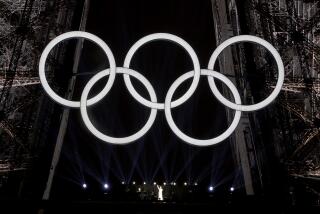French Town Steeped in Tradition
- Share via
L'ALPE D'HUEZ, France — They come, a constant parade of bike riders, pedaling through 21 hairpin curves, up and up, 8.7 miles, 6,102 feet in thinning air and with the road pitched sometimes at a grade of 14%.
At the top is a small, neat town of about 1,500 residents who yearn for ski season and the one day every few years when the Tour de France comes to their home.
More cows than people are permanent residents at this place that teeters on a mid-sized peak in the Alps and is named after owls that cry in the night.
“We encourage the cows,” Mayor Eric Muller says. “The cows eat the grass. Short grass means fewer avalanches. Tall grass encourages the avalanches. So we encourage the cows.”
The bicyclists -- amateurs, not Tour riders -- need no encouraging on a hot, summer Friday.
There are men with only a few strands of hair, men with bellies hanging over their shorts. There are women pedaling, walking, pedaling, walking. One after another they are making a pilgrimage of pain and wretched frustration, of grim determination, and finally of exquisite excitement when the sign says “L’Alpe d’Huez, 4 kilometers.”
“You see some come in looking near death,” says Madeline, a waitress at Crepes a Coco, a tidy little restaurant with a patio filled with sunlight and a snow-capped peak in the distance. “You see some coming in ready to eat and drink. But they all come to pretend they’ve won the Tour. That’s what they say.”
Madeline -- “My last name, it’s not important,” she says -- lives for this weekend.
“When it is announced the Tour is stopping here, OK, we say, this is great for business. Our crepes will sell.”
Down the street, the Pacific Pub advertises in French and English “BBQ and race on Eurosport.”
And about a mile away, at the top of the mountain, the parade of exhausted bikers continues. “I’m doing it because it’s what the heroes of the bicycle do,” says Henri Voiton, 26, of Nice. “For a moment I pretend I am Lance Armstrong.”
Armstrong, the 31-year-old from Austin, Texas, was, in 2001, the last winner of the most dramatic stage of the Tour de France, which on Sunday will start in Sallanches and conclude after 136 miles and the climb to L’Alpe d’Huez.
After Friday’s sixth stage, Armstrong, a four-time Tour champion, was in second place overall, positioned perfectly to take over the race in its most mountainous stages, when he usually excels.
The Tour brings riders up these 21 hairpin turns -- each turn marked -- No. 21 at the bottom, No. 1 closest to the top -- so the bicyclist knows how much agony is still to come. Since it began in 1903, the Tour, which is rerouted each year, has come to L’Alpe d’Huez 21 times.
Along the length of the ascent, two days before the race, the narrow road is already closed in with cars and campers, motor homes and tents. There are lawn chairs and coolers and flags waving. The flags are from France, of course, and Denmark and Switzerland. The black, red and yellow of Germany is at nearly every one of the 21 signs and the orange of the Netherlands covers the road sides as if in one, glorious blanket.
By the start of Sunday’s stage -- the eighth of 23 in the Tour -- a crowd of 400,000 will line the road from sign post 21 to the top. Maybe even 500,000, some say, because Monday is Bastille Day and this is a holiday weekend.
“I think it’s clear,” Muller says, “that when people around the world hear the name of our town, they think one thing: Tour de France. What has happened for our town is that the world watches the best riders go by the 21 turns and it makes their hearts stop. Then, they remember us.”
The L’Alpe d’Huez didn’t become part of the Tour until 1952. Organizers were always fiendishly interested in bringing more agony to the event and this mountaintop ski area, home to cows that ate the grass which prevented avalanches, seemed able to provide that agony.
An Italian, Fausto Coppi, won the L’Alpe climb -- and the race -- that first year. A single camera attached to a motorcycle recorded his victory.
“The images seemed to stay with everyone,” says Muller, who moved to L’Alpe d’Huez in 1940 when he was three weeks old. “And yet, the race didn’t return here until 1976.”
When, in 2001, Armstrong became only the second man to win both the L’Alpe stage and the Tour, television recorded his astounding achievement, a performance considered one of the greatest ever.
It seemed Armstrong spent a good portion on the road approaching the L’Alpe climb appearing as if he were barely able to stay on his bike. Seeing that, leading contender Jan Ullrich and his team put on a burst of speed, hoping to finish off the American.
But when he approached the foot of the climb, the first of the turns, Armstrong threw aside his look of pain, his seeming exhaustion, and took off as if he were riding on a Kansas prairie. As he caught Ullrich, Armstrong turned and stared for a long moment. Then the American upped his speed again, leaving Ullrich stunned, demoralized and a loser.
“I was bluffing,” Armstrong said after he won the stage and set himself up for the third of his four Tour victories. “I fooled them.”
On Friday, two days before the Tour was to arrive here, more than 100 amateur riders, men and women, crossed the finish line in their own mini-Tour.
Along the way, many dozens more had given up, or at least stopped to rest.
Two riders stood together, vomiting over a railing while some German campers chanted.
“We tell them, ‘Do not quit, do not quit,’ ” says Horst Muehlmann of Hanover. “Me and my friends, we want to offer encouragement. Because we could never do this.”
Muehlmann pointed to his ample belly and then to a cooler of beer. “We will drink to you, not ride with you,” he said.
Mayor Muller says that all who ride to the top receive a certificate signed by him. “Yes, we trust people to tell us the truth,” he says. “I think most people are honest.”
It takes almost everyone in town to get ready for race day, says Marie-Helene Pascal, who works for the tourism office and who will be walking to the office for the next couple of days. No room to drive.
“We must put up the barriers, we must erect stages and put up signs,” she says. “There are only 12 hotels but many more rooms in apartments and ski chalets. Every person who can works in every restaurant. And we must look over the poor, sun-burned souls who are in their tents and campers for as many days as a week.”
Even on the most crowded ski weekend, Mayor Muller says, there are, at most, 4,000 or 5,000 people in the area.
But the intrepid cyclists making the climb Friday aren’t doing it as the final portion of a 136-mile ride, as the Tour de France will demand Sunday. They haven’t already climbed up the 5,137-foot Col du Telegraphe or the 5,085-foot Les Verneys or the 8,677-foot Col du Galibier as the Tour riders will.
And, of course, there is still a long way to go. The race, which started a week ago, doesn’t end until July 27 -- after more than 2,100 miles.
In honor of the 100th anniversary of the first Tour, Mayor Muller has invited the living winners of the L’Alpe d’Huez to town.
Muller says Joop Zoetemelk (1976, 1979), Hennie Kuiper (1977, 1978), Peter Winnen (1981, 1983), Bernard Hinault (1986), Federico Echave (1987), Steven Rooks (1988) and Roberto Conti (1994) are confirmed, as is Faustino Coppi, son of Fausto.
There will be fireworks and a party tonight. The past winners will be honored Sunday with a special ceremony after the racers have arrived.
“I very much hope that Lance Armstrong will also stand with them,” Muller says. “I have never met him, but should he win again, another two-time winner, he should be on the podium I think.”
More to Read
Sign up for The Wild
We’ll help you find the best places to hike, bike and run, as well as the perfect silent spots for meditation and yoga.
You may occasionally receive promotional content from the Los Angeles Times.






